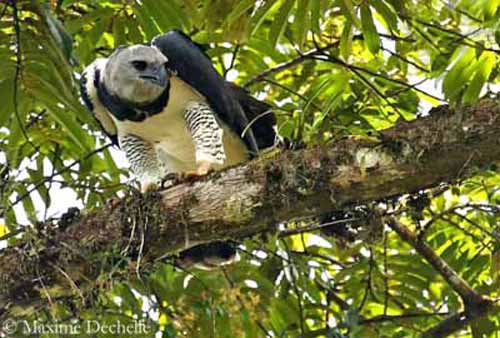
Photographers :
Marc Chrétien
MURINUS
Maxime Dechelle
LEPAPARRAZO
Tom Merigan
Tom Merigan’s Photo Galleries
Illustrations :
John Gerrard Keulemans : 1842-1912
John Gould : 1804-1881
Henrik Grönvold : 1858-1940
Text by Nicole Bouglouan
Sources :
HANDBOOK OF THE BIRDS OF THE WORLD Vol 2 by Josep del Hoyo-Andrew Elliot-Jordi Sargatal - Lynx Edicions - ISBN: 8487334156
A GUIDE TO THE BIRDS OF MEXICO AND NORTHERN CENTRAL AMERICA by Steve N. G. Howell, Sophie Webb - Oxford University Press - ISBN: 0198540124
A GUIDE TO THE BIRDS OF COLOMBIA by Steven L. Hilty and William L. Brown - Princeton University Press – ISBN 069108372X
PORTRAITS D’OISEAUX GUYANAIS - Groupe d'étude et de protection des oiseaux en Guyane (GEPOG) - Ibis rouge éditions - ISBN: 2844501842
A photographic guide to Birds of the Philippines by Tim Fisher and Nigel Hicks. New Holland Publishers. ISBN: 9781847738301
The Peregrine Fund – World Centre for Birds of Prey
Wikipedia (Wikipedia, The Free Encyclopedia)
BirdLife International (BirdLife International)
The large eagles
Genera Harpia, Morphnus, Pithecophaga and Harpyopsis
Four large eagles are included in the ninth group of the Family Accipitridae, and are among the largest birds of prey in the world.
They share a peculiar feature by having unfeathered tarsi.
The genera Harpia (Harpy Eagle) and Morphnus (Guiana Crested Eagle) occur in the tropical rain forests of the Americas.
The genus Pithecophaga (Great Philippine Eagle) is found in the same type of habitat in the Philippines.
The genus Harpyopsis (New Guinea Eagle) frequents the humid forests of New Guinea.
These large birds could be some remnants from old lineages.
These four raptors are difficult to find and to see. They are living in dense humid forest, often in undisturbed areas. They come along clearings and edges for hunting. They perch and wait for preys from high branches where they may sit for long periods.
To find one of them is a beautiful gift. These species are rare, near-threatened, vulnerable or endangered, due to hunting pressure and deforestation.
The large birds, and especially the raptors, are always impressive for humans who love or hate them. Unfortunately, they are killed for nothing, often wrongly accused of damages to farming and rearing.
We are going to study each species, but they have very similar habits and behaviour.
The Harpy Eagle (Harpia harpyja) is a massive raptor with a length of 90-105 centimetres, a wingspan of 200 centimetres and a weight of almost 5 kg for the male and 8-9 kg for the female.
Upperparts are dark grey, whereas underparts are white, with blackish breast band between the underparts and the pale grey head. The thighs are finely barred black. The long tail shows broad black and white bars. Wings are rounded and relatively short.
On the head, the divided crest is dark grey. Bill and cere are greyish. Eyes are grey. The powerful legs and feet are yellow, with robust black claws.

The Harpy Eagle frequents the tropical forest usually below 800 metres of elevation, rarely higher. It hunts in forest patches, often in areas with pastures and forest. It sits on perch in the canopy, around clearings and edges, and also beside rivers or salt-licks. The attack is rapid. The prey is caught with the long claws, and may be carried to a fallen tree if too large.
This large eagle is able to hunt and fly through the forest thanks to the short, rounded wings.
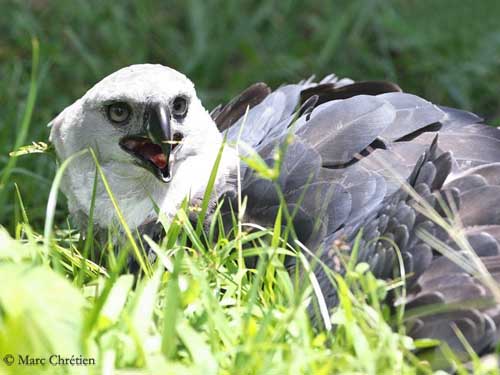
The preys include large vertebrates such as monkeys, sloths, porcupines, and terrestrial mammals, domestic pigs and young deers. It also takes birds such as parrots, macaws, curassows and several other species.
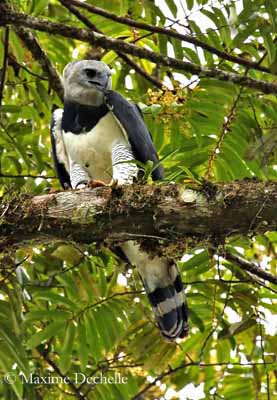
During the breeding season, the Harpy Eagle becomes very aggressive at nest-site, and attacks the intruders, even a human.
This monogamous species nests in tall trees, where it builds a huge nest with large sticks.
During the rainy season, the female lays two eggs, but only one chick survives. Incubation by female lasts about 56 days. She is fed by the male during this period. The chick fledges between 4 and 6 months after hatching, but it remains within the nest-site during one year.
This species breeds only every third year.
The Harpy Eagle is sedentary in its range from S Mexico through Central America and in the northern half of South America.
The species is evaluated as Near Threatened. It is sparsely distributed and rare throughout its wide range. It is threatened by hunting pressure and deforestation, making suitable nest-sites unavailable. In addition, it has slow reproductive rate.
Several captive breeding programs are active, in order to release these raptors in suitable habitats.
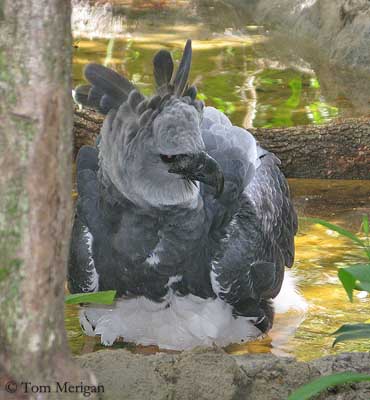
The Guiana Crested Eagle (Morphnus guianensis) is smaller than the previous with a length of 71-84 centimetres, a wingspan of 135-175 centimetres and a weight of 1750 grams.
This raptor has two main morphs. In pale morph, head, neck and breast are pale grey to brownish. The upperparts are blackish-brown. Underparts and underwing-coverts are white, finely barred cinnamon. The long tail is boldly barred black and white.
In dark morph, the bird is similar but the underparts are black, or black narrowly barred white.
Bill and cere are blackish. Eyes are dark brown to grey, sometimes pale yellow. Legs and feet are pale yellow.
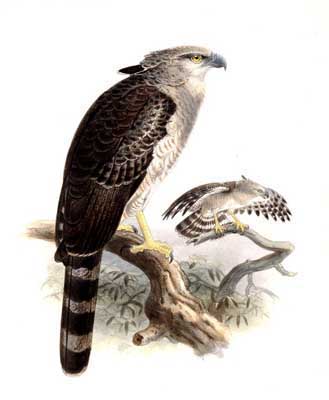
Guiana Crested Eagle - Pale morph
Morphnus guianensis
John Gerrard Keulemans
The Guiana Crested Eagle frequents lowland humid forests, and also gallery forest in the southern part of the range. It is found from Guatemala and Honduras to Colombia, S to Paraguay and NE Argentina. The species can be seen between 600 metres and probably 1000 metres of elevation in Colombia.
It hunts from perch where it sits for long periods waiting for preys. Its preys include both arboreal and terrestrial snakes, arboreal rodents, birds and tree frogs.
Some observations talk about attacks towards Grey-winged Trumpeters (Psophia crepitans), Guianan Cocks-of-the rock (Rupicola rupicola) and monkeys.
This raptor may soar slowly over the canopy, maybe for hunting.
The breeding behaviour is poorly known, but this species builds a bulky stick nest in large tree, and it becomes vocal near the nest.
The female lays two eggs, but probably only one young is raised. The female incubates and is fed by the male during this period.
One month after hatching, both adults provide food to the chick. The male calls when arriving at nest, and remains a few minutes after giving the food. The female always returns to the nest with food or nest materials.
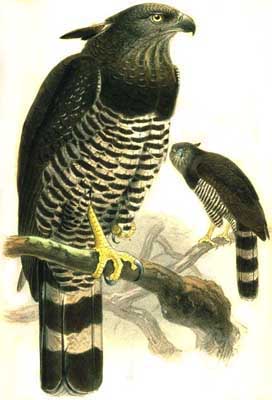
Guiana Crested Eagle - Dark morph
Morphnus guianensis
John Gerrard Keulemans
The Guiana Crested Eagle seems to be sedentary in its range.
The species is evaluated as Near Threatened and rare. It is vulnerable to hunting pressure and deforestation. In addition, the dense habitat makes difficult to see these raptors.
The Philippine Eagle (Pithecophaga jefferyi) is really huge with a length of 86-102 centimetres and a weight between 4700 and 8000 grams.
The upperparts are brown with paler edges and the underparts and underwing are creamy-white with some pale rufous streaks on thighs and breast. The long brown tail is broadly barred black.
But the peculiar feature of this species is the shaggy crest formed by long feathers on head and nape. The feathers are creamy-buff with blackish streaks.
The large bill is black with bluish-black cere. The eyes are blue-grey. Legs and feet are yellow.
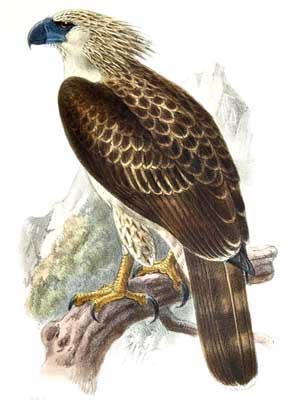
This large eagle occurs on the larger islands of N and E Philippines where this species is sedentary. It frequents the primary and gallery forests up to 2000 metres of elevation in steep areas. It can be seen in remnant patches of forest in more open landscapes.
It hunts from perches in canopy inside the forest. It moves from perch to perch to reach the bottom and comes back to the treetops again.
The members of a pair may hunt together. One of them disturbs the monkeys while the other attacks them from behind. But it also feeds on several species of arboreal mammals, snakes, lizards, birds (hornbills, owls and hawks) and bats. This huge raptor is able to attack large preys.
It flies fast and is very agile in spite of its size.
During the breeding season, aerial displays are observed with the pair soaring over the territory and the nest-site, some chases between mates and presentation of talons while flying. Loud calls often accompany these displays.
The beginning of the season involves the building of the nest. They bring nest materials and an eagle remains in the surroundings. The copulation follows and occurs repeatedly at the nest-site.
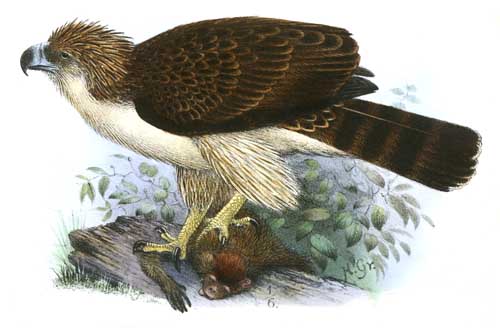
The huge nest is build by both adults in the canopy of a large tree, up to 30 metres above the ground. The female lays one egg and both sexes incubate during two months. The white downy chick is fed and brooded by the female while the male hunts and brings food to the nest. The young fledge 23-24 weeks after hatching, but it depends on parents for more than one year.
In this species, the breeding cycle lasts two years.
The Philippine Eagle is evaluated as Critically Endangered, due to rapid declines as the result of deforestation and destruction of the habitat. Hunting, poaching and use of pesticides are also important threats.
Several breeding programs in captivity are active, in order to reintroduce this majestic eagle into a suitable habitat, and protected areas have been created for them.
The Philippine Eagle is the National Bird of the Philippines.
The New Guinea Eagle (Harpyopsis novaeguineae) is smaller with a length of 75-90 centimetres,
a wingspan of 157 centimetres in female, and a weight between 1600 and 2400 grams.
This is a large forest eagle with brown upperparts slightly mottled pale buff. The long tail is brown and finely barred darker brown with broad terminal bar. The flight feathers are brown barred darker brown. The underparts are white with pale brown upperbreast.
Head and neck are paler brown, with erectile ruff around neck and face.
The powerful hooked bill is horn coloured with grey cere. The eyes are brown. Long bare legs and feet are yellow.
This eagle is sedentary in New Guinea, Indonesia and Papua New Guinea. It frequents the undisturbed forests from lowlands up to 3200 metres of elevation. It can also be seen in gallery forests and clearings. It nests in forest.
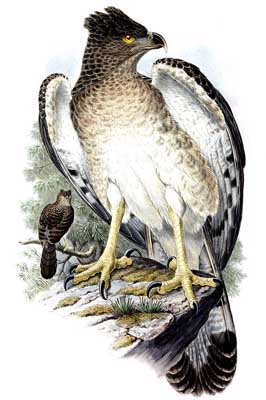
New Guinea Eagle
Harpyopsis novaeguineae
John Gould
It hunts from several perches in the forest canopy. It waits for several minutes, using the facial ruff for better detection of prey by sounds. If prey is not found, it flies through the canopy to another perch. When the prey is detected, it swoops down onto it, but it is able to pursue the prey by running if necessary, thanks to the long bare legs. It also takes arboreal preys by clambering among the branches, and flushes them by moving its wings or disturbing the vegetation with the feet. It also uses the feet to extract preys from holes.
It feeds mainly on terrestrial and arboreal mammals, but also takes birds, snakes and lizards.
The breeding and nesting behaviours are poorly known. This eagle nests in tall tree at about 20 metres above the ground. The large nest is made with sticks and reused year after year.
Some observations reports talk about one single chick.
The New Guinea Eagle is evaluated as Vulnerable, due to habitat loss, hunting for its feathers which are used in ceremonial hair-dressed, and competition with human hunters for mammals.
It occurs in several protected areas and is protected by laws, but hunting pressure continues.
These four large eagles are all threatened by habitat loss and hunting pressure. In the future, we will see them only in zoos. There are so majestic and impressive when hunting or moving among the branches where they are living. The nature needs them and we have to protect and to respect them if we wish to keep them alive and in wild.
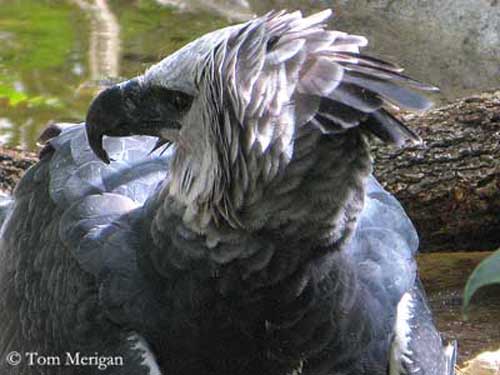
Harpia harpyja